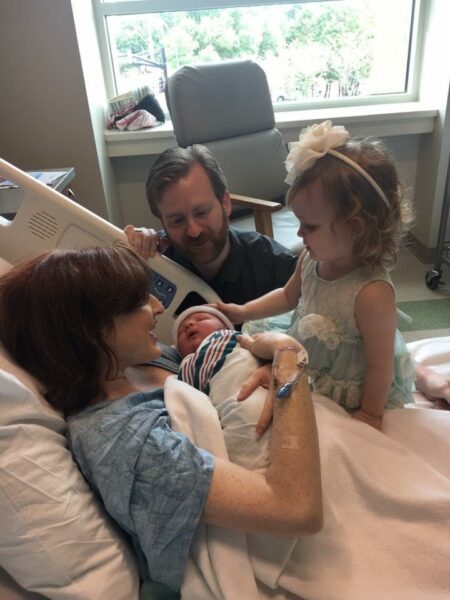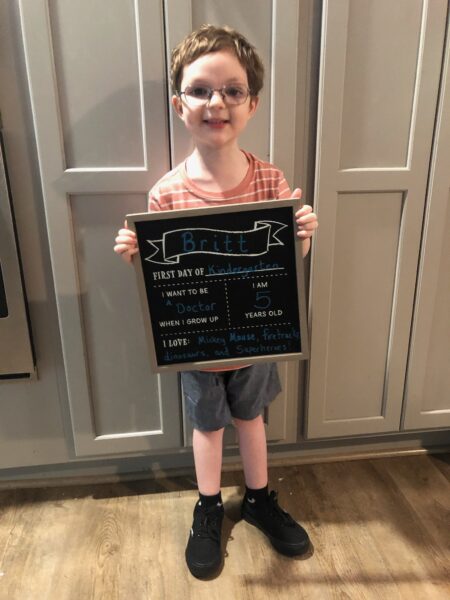Britt’s family experienced many emotions when they learned he was diagnosed with hearing loss from Waardenburg syndrome. They were relieved to have a diagnosis and a solution of cochlear implants to help their young son. After receiving bilateral cochlear implants, Britt now loves music and his devices even led his father to patent an invention! Learn more about Britt’s story:
“When our son, Britt, was born, we were expecting the normal hospital stay and the sometimes-blissful, often-exhausting first few months of odd sleep schedules, family visits and pediatrician appointments. He was born without any real complications and soon was perfectly happy being cradled, enjoying his bottle, sleeping and crying.
The second day of his life, a technician came into the hospital room to run a newborn hearing test on our son. I had a work call to take, so I stepped out of the room so I wouldn’t affect the results. When I came back in, my wife, Micah, had a serious look on her face, the kind of look I have learned means she is trying to solve a problem. She turned to me and sharply said: ‘Daniel, he failed his test.’
The next few hours and days I recall only as a confusion of surprise, loss, investigation, options, conversations and conclusions. A kind family that Micah worked with had a deaf child, and reached out to help us navigate what we could expect. I found myself grateful for kind people who wished us well and, unexpectedly, angry when people would act like Britt’s deafness was a tragedy. I remember the first time a person described Britt as being a ‘special needs’ child. I had to restrain myself from shouting: ‘He’s a regular kid! He just can’t hear.’
 Diagnosis brings understanding and solutions
Diagnosis brings understanding and solutions
As we went from appointment to appointment, we ruled out one possible cause for his hearing loss, then another. In the midst of it all, we navigated a cross-country move, a new job and house, a failed attempt at hearing aids, and, finally, a diagnosis: profound bilateral hearing loss from Type 2a Waardenburg’s syndrome. It was a relief to know what we were dealing with, and to have some knowledge of how we would address it, for we now knew cochlear implants were an option for our son.
We of course researched the different cochlear implant options, and debated the pros and cons of all. We decided to go with a Cochlear™ Nucleus® 7 Sound Processor because—of all things— a phone call.
We were calling cochlear implant companies to learn more about their processors and understand the experience of wearing them. We wanted to speak to actual users.
The first company we tried made us navigate a multiple-prompt phone tree before having us leave a voice message. When we called Cochlear, however, an operator picked right up and transferred us to a cochlear recipient who had a wonderful conversation with us about what we could expect. After hanging up, Micah summed things up perfectly: ‘When we need customer service in a year or two, will you want to speak to a person right away, or have to leave a voicemail?’
 Cochlear implants expand Britt’s horizons
Cochlear implants expand Britt’s horizons
Britt was implanted at 13 months old1 and had his cochlear implants activated soon thereafter. Our family flew up for the occasion, expecting perhaps one of those joyful scenes we had seen on so many online videos. We now know that was a slightly unrealistic expectation: Britt responded to his new sense by covering his eyes and going quiet. He was trying to understand this new sensation. I suppose, in a manner of speaking, we all were.
Since then, Britt has gone from a loud, sometime distant baby, to a bright, driven, excited, curious, super kid. Though I’m sure many of these changes would have occurred even without cochlear implants, they have undoubtably expanded his horizons. He matches pitch when Micah sings opera. He has become such a talker that we have to sometimes tell him he’s talking too much, to which he responds, ‘but, I love talking. Talking’s my favorite!’
 Britt’s sound processors spark an idea
Britt’s sound processors spark an idea
When Britt was 4, we found that, like so many other children with Waardenburg’s syndrome, he had a refractive error, which was causing bilateral amblyopia, or ‘lazy eye.’ Britt would be wearing both spectacles and cochlear implants for the rest of his life. This revealed something: it is often challenging for children who must wear spectacles and sound processors to easily fit them both above their ears. Since I am an optometrist, I worked with my colleagues to develop an adapter, the Protoconch, that connects cochlear processors with spectacles, so children and adults can more easily wear them both. Our family is excited to develop this concept and help other people like our son.
When Britt’s lazy eye was diagnosed, so was a deficiency in eye movements, 3-D vision and fine motor control. We began a strategy of vision therapy, occupational therapy and auditory-verbal therapy to address these concerns. It didn’t take long for Britt to significantly improve; whereas before, he couldn’t appreciate depth and rarely drew for fun, now Britt reaches for objects during 3-D movies and draws a mean Mickey Mouse.
Today, Britt is learning to read, play the piano, dance and do gymnastics. Micah, a coloratura soprano, was worried he would never appreciate music; now, he’s participating in creating it. He does not consider himself any different from the rest of his family. He simply gets to take off his ‘ears’ at the end of the day. It’s the most normal thing in the world for him, and for us.
When Britt was first diagnosed with profound hearing loss, Micah and I didn’t know what to make of it. For months, we were occupied with trying to understand this unexpected reality. If you are reading this and find yourself in a similar situation, please know, it gets better. You are making the right decisions.”
If your child has been diagnosed with hearing loss from Waardenburg syndrome, cochlear implants may be a solution – discover the benefits of cochlear implants today!
- In the US, the cochlear implant system is intended for use in children 9 to 24 months of age who have bilateral profound sensorineural deafness and demonstrate limited benefit from appropriate binaural hearing aids. Children two years of age or older may demonstrate severe to profound hearing loss bilaterally. In Canada, the cochlear implant system is intended for use in children 12 to 24 months of age who have bilateral profound sensorineural deafness and demonstrate limited benefit from appropriate binaural hearing aids. Children two years of age or older may demonstrate severe to profound hearing loss bilaterally.